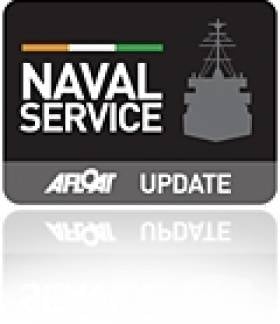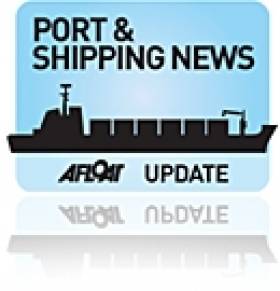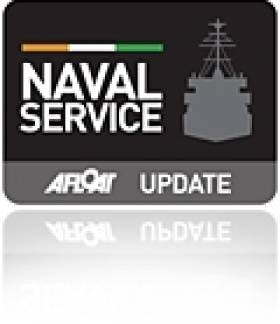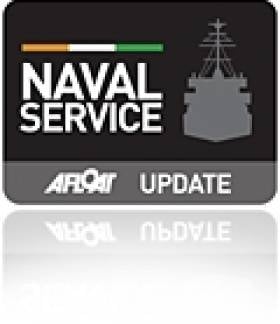Displaying items by tag: naval service
Fishery Detentions off Clare Coast
#FISHERY DETENTIONS – Yesterday the Naval Service OPV L.E. Aisling (P23) detained an Irish registered vessel approximately 125 nautical miles off the coast of Loop Head, Co. Clare. The detention was in relation to an alleged breach of technical fishing regulations.
The vessel was to be escorted by the OPV to arrive in Castletownbere this morning and then and handed over to the Gardaí.
Also earlier this month, the LPV L.E. Niamh (P52) detained another vessel on the same grounds. On that occasion the detained French registered vessel was likewise fishing in waters off Loop Head and taken under escort to the Co. Cork fishing harbour.
According to Naval Service figures, they have carried out 910 boardings, issued 38 warnings and detained 11 vessels so far this year.
#NAVAL SERVICE - The Irish Times reports that a Russian vessel suspected of shipping arms to Syria was under surveillance by the Naval Service earlier this week.
The 130m cargo ship MV Alaed - with a stated destination of Vladivostok in the far east of Russia - appeared to be headed for the western coast of Ireland, and the Naval Service were preparing to board and search the ship pending legal advice.
But the Naval Service and Irish Coast Guard both stood down their watch when the vessel changed course off Scotland, after its insurance cover was revoked.
Standard Club, the UK-based insurer, confirmed it withdrew its cover due to the allegations that the MV Alaed was carrying arms destined for Syria in breach of EU sanctions.
Ships have the right of free passage in international waters provided they are flying their flag and pose no imminent threat to the marine environment.
The Irish Times has more on the story HERE.
#NAVAL SERVICE – The Irish Maritime and Energy Resource Cluster (IMERC), based in Haulbowline, Co. Cork, has won an award at the Taoiseach's Public Service Excellence Awards.
Minister for Justice Equality and Defence, Alan Shatter TD, was delighted to congratulate the Irish Naval Service for the award won by IMERC. The Naval Service was one of four areas within his departments to win an award at a ceremony held yesterday in Dublin Castle.
The Minister said "IMERC is a unique example of joined-up-thinking across three public sector institutions, the Irish Naval Service as an element of the Defence Forces under the Department of Defence, University College Cork and the Cork Institute of Technology.
He added, "This collaboration has produced results that have leveraged major capital investment, succeeded in attracting inward investment, supported indigenous industry and enhanced capacity for research and innovation in Ireland's maritime sector."
The cluster concept is the first such project to have been selected for the Taoiseach's National Awards and in which was among 20 selected for its 'innovation' and potential 'excellence' of the 190 applications.
The developing IMERC campus is to feature the world's largest energy renewable centre. The cluster aims to create up to 52,000 jobs in the wave energy technologies sector by 2020.
Dublin Bay Ceremonies for OPV L.E. Roisin
#COMMAND CHANGEOVER CEREMONY– The offshore patrol vessel OPV L.E. Róisín (P51) arrived to Dun Laoghaire Harbour today for the official reopening of the town's maritime museum and follows a changeover command ceremony held on board the vessel in Dublin Port last Friday, writes Jehan Ashmore.
At the ceremony the Lord Mayor of Dublin, Cllr Andrew Montague along with the Flag Officer Commanding the Naval Service, Commodore Mark Mellett presided over the command handover along Sir John Rogersons Quay.
This saw Lieutenant Commander Terry Ward, who is originally from Dublin, take over command from Lieutenant Commander Peter Twomey of the OPV which was adopted by the City of Dublin in 2000 and has maintained a strong connection with the capital.
The OPV departed on Sunday on a short patrol in the north Irish Sea until returning to Dublin Bay this morning. She berthed at the East Pier in Dun Laoghaire Harbour where at the nearby National Maritime Museum of Ireland, senior officer ratings and a party of 20 crew members made a guard of honour for President Michael D. Higgins who officially reopened the €4m renovated building.
The President is the supreme commander in chief of the Defence Forces and also is patron to the Maritime Institute of Ireland which was established in 1941 and runs the maritime museum in Dun Laoghaire.
#PORTS & SHIPPING REVIEW – Dublin 'Docklands' floating river-restaurant ship M.V. Cill Airne celebrated her 50th anniversary having been built nearby at the Liffey Dockyard. A special lunch and lecture organised by the Cobh branch of the World Ship Society was held on board the veteran vessel which represents one of the last surviving ships built in Ireland and which remains around our coast having had a rich and varied career.
Along the Shannon Estuary the mid-west port of Foynes welcomed the first cruise call for this year with the arrival of the 28,000 tonnes ultra-luxury Silver Whisper. Passengers from the 382 capacity cruiseship toured the region including the local Foynes Flying Boat Museum.
Returning to the East coast where in Drogheda Port, onlookers welcomed the first ever scheduled cruise call to the Boyne when the Clipper Adventurer berthed at the Co. Louth port to complete a circumnavigation cruise of the island where US and Canadian passengers disembarked.
Down the coast the RV Keary was undergoing refit at Arklow Marine Services yard. The research vessels owners Geological Survey of Ireland (GSI) have chartered the Cosantoir Bradan from the Central Fisheries Board for survey work to assist the RV Keary.
In the capital the veteran grab-hopper dredger Hebble Sand (1963/757grt) departed Dublin Dry-Dock facility in readiness for a new career working with Northern Ireland based Abco Marine. The former Dundalk Port Company owned vessel which resembles the last of the Guinness ships, currently remains in the port awaiting her first delivery voyage for contract project work.
Across the Irish Sea the first of two new offshore patrol vessels (OPV) for the Naval Service had its keel-laid at a ceremony at Babcock Marine's shipyard in Bideford, north Devon. The €99m pair are an enlarged version of the 'Roisin' class L.E. Roisin (P51) and L.E. Niamh (P52) which were launched from the same UK yard over a decade ago then owned by Appledore Shipbuilders.
#NAVAL SERVICE NEWBUILDS - Minister for Justice Equality & Defence, Mr. Alan Shatter, T.D., announced on Friday that the building of new Naval Service offshore patrol vessels (OPV) ships is well underway.
The keel laying ceremony of the first of two OPV's took place at Babcock Marine's shipyard in north Devon. Senior representatives of the Naval Service and the Department of Defence attended the ceremony at the UK shipyard which won the €99m contract to build the pair in 2010.
The cost is exclusive of VAT and subject to contract terms and final agreed costs. In addition the cost of providing a weapons system for the ships, similar to the systems on the LE Roisin (P51) and LE Niamh (P52) will be €7.8m, exclusive of VAT.
This pair are of the 'Roisin' class OPV's which were built at the same Devon yard then owned by Appledore Shipbuilders. The newbuilds are of the PV90 design which are a lengthened version of the PV80 class, which were also designed by STX Canada Marine and completed by Appledore in 1999 and 2001.
The PV90 newbuilds will retain the overall configuration of the PV80 but will be increased in length by over 10 metres. They are also to have a slightly deeper draft for improved sea-keeping while patrolling in rougher waters particularly throughout Ireland's extensive naval duties in the Atlantic.
In addition there will be more space at the aft-deck to load on board containers and an increased speed to 23 knots. The will be crew for 44 personnel plus additional quarters for 10 trainee crew.
The payment contract schedule has been arranged over an eight-year timeframe, being 2010 to 2017 and funded from within the annual Defence budget.
The first newbuild is due for delivery in early 2014 followed by the second vessel in 2015. The PV90 class are to replace two of the older Naval Service ships from operational service while maintaining an eight-strong fleet.
Busy Patrol Vessel Detains Second Trawler
#NAVAL SERVICE – Within a space of seven days the Naval Service OPV L.E. Roisin (P51) detained two foreign registered fishing vessels for alleged breaches of fishing regulations.
The most recent detainment was on Tuesday where a UK registered trawler was approximately 33 nautical miles off Mizen Head, Co. Kerry. The detained vessel was escorted to Castletownbere and handed over to the Gardai.
As previously reported on Afloat.ie the other detention took place last week where a Spanish fishing vessel was 150 miles south-west off Co. Clare. and likewise the trawler was escorted to Castletownbere.
To date the Naval Service have carried out 426 boardings, issued 17 warnings and detained four vessels so far in 2012. The navy last year carried out 1,313 boardings and eight detentions of vessels off the Irish Coast.
Royal Navy Attend Presidential Fleet Review for Cobh Titanic 100
#COBH TITANIC 100 - Following President Michael D. Higgins visit to Cobh to commemorate the centenary call of RMS Titanic to Queenstown, the town yesterday hosted a Naval Service review that included the Royal Navy's HMS Mersey.
The President as supreme commander of the Defence Forces boarded the Naval Service 'flagship' L.E. Eithne which passed the guest-ship, a River class patrol vessel which headed a line of vessels which lay at anchor of Cobh's waterfront, they were the L.E. Aoife, L.E. Aisling and L.E. Niamh
The historic event which marked the pinnacle of the Titanic 100 Cobh centenary week will continue as part of a year-round programme of events. For information visit www.titanic100.ie. On the homepage the L.E. Niamh features again, where on this occasion marine photographer Jehan Ashmore captured the vessel underway as she powered her way at high-speed through a misty Dalkey Sound.
Among the many places throughout Cobh where thousands of tourists have flocked since the Balmoral docked on Monday to retrace the liner's maiden voyage, has been the White Star Line pier.
From this pier were the last passengers to depart Queenstown on board the tenders PS Ireland and PS America to the ill-fated Titanic that struck an ice-berg. On her Irish call 123 passengers were transferred to the Titanic which lay outside Cork Harbour, while 7 passengers disembarked from the liner and headed ashore.
What remains of the pier which is not accessible to the public and is in danger of collapsing, there has been calls to raise funds to save the structure, as previously reported.
Also in attendance during yesterday's historic proceedings, was the excursion passenger tender Spirit if the Isles which is operating on her second season since starting Cork Harbour cruises last year. They run between Cork city quays and downriver along the Lee to Cobh.
In the 1980's the tender then named Ingot ran excursions from Dun Laoghaire Harbour into Dublin Bay and likewise of L.E. Niamh, she too transited Dalkey Sound as part of her sightseeing tours.
- RMS Titanic
- White Star Line
- Cobh Cruise Callers
- Cobh, Cork Harbour
- Cruiseships
- Balmoral
- FredOlsen Cruise Lines
- Titanic Memorial Cruise
- naval service
- LEEithne
- Royal Navy
- HMS Mersey
- President Michael D Higgins
- Queenstown,Ireland
- PS Ireland
- PS America
- Spirit of the Isles
- Cork Harbour Cruises
- Cork Harbour News
- Dalkey Sound
- LE Niamh
- LE Aoife
- LE Aisling
- Cork Harbour
- River Class Patrol vessels
- River Lee
- Irish marine photographers
Sail-Pass of Island Beacon in Memory of Titanic
#ISLAND NEWS – A beacon is due to be lit early this afternoon (2 – 3pm) on Cape Clear Island, marking the 100th anniversary today of the RMS Titanic's departure from Cobh (Queenstown) where the doomed liner continued on her maiden voyage into the Atlantic.
The beacon at Fiona's Land is accessible by a walking trail and is where the Naval Service L.E. Aisling (P23) is to recreating the liner's voyage by passing off the southern side of the Co. Cork island.
For information on island life, activities and events, follow the Cape Clear Ferry blog HERE.
Naval Service Seeks Recruits
#NAVAL SERVICE – The Naval Service are currently accepting applications for General Service Recruits.
There are additional positions available within the Defence Forces for General Service and Specialist positions.
For information on all these appointments, noting the relevant links for further details can be found by visiting: www.military.ie
The navy has a fleet of eight vessels led by the flagship LE Eithne (P31), to see the list click HERE.







































































